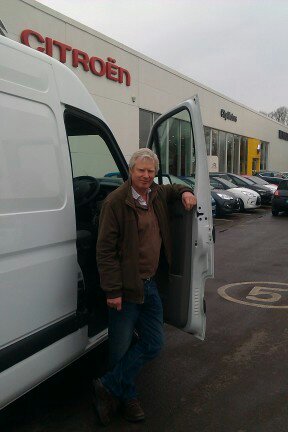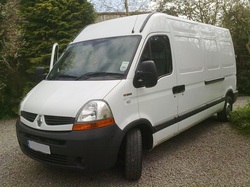I am now a White Van Man, and proud of it!
I realised there is much to consider in the area of insurance and also regarding registration with the DVLA.
Despite the reputation of white van man as a driver ,white vans are relatively cheap to insure as statistically they are less likely to have an accident than a private car.
There are some issues when deciding to insure a self-build campervan as you will be(hopefully!) turning it from a goods vehicle into a campervan(or "motor caravan" in DVLA parlance),over a number of months.You need to insure with one of the specialist insurers who factor this in.Several are found easily on the internet.
I got a no hassle quote from Shield Insurance,for a price cheaper than my car,including cover for 3 months per year anywhere in Europe*, with Europe wide breakdown cover included*.Extensions to these time periods are easily obtained but you just need to pay an additional premium.3 months per year should suit nicely as I plan to be in Europe for part of this insurance year,and part of next.
*(NB this was pre-Brexit,when any EU domestic insurance covered the bare minimum legal insurance, (i.e third party damage )automatically in other member states.Things may change on this .Another issue that only became apparent later was that while this (fully comprehensive) insurance did allow for driving in non EU European countries so long as you warned the insurers and paid a small additional fee and a "Green Card" was provided for me by the company,the breakdown cover did not extend to some countries outside the EU . I then had to buy an additional European breakdown policy from the AA which did cover non-EU countries (such as Montenegro,Serbia,Albania etc),as well as the EU.Having a Green Card was vital outside the EU:I had my papers checked at several police roadside checkpoints and borders, notably in Bosnia and Albania,and my Green Card ,indicating adequate insurance,was scrutinised closely)
The only issue is that the insurance policy from Shield stipulates that my conversion must be completed in 3 months,with photographic evidence.Complete means being re-registered by the DVLA as a "motor caravan",and for this one needs certain minimum requirements to differentiate your conversion from an ordinary white van that you might simply camp in the back of.
There actually seem to be some other compelling advantages for getting your van re-classified anyway:The following is lifted from www.campervanlife.com/building/legal
Why re-register as a "Motor Caravan"? Although you do not legally need to re-register a campervan conversion, here are the benefits of doing so:-
The one thing that I would add to this is that very occasionally campsites of the smarter type get a bit shirty if you turn up in what looks basically like a white van,and ask you to prove that you are registered as a motorhome. This has actually only happened to me once(in Finland).
So,for a vehicle to qualify as a 'Motor Caravan' in the eyes of the DVLA the following permanent fixtures must be present,and you have to send photographic proof of compliance to the DVLA with the re-registration application:-
Wow! ,3 months to completion sounds pretty optimistic to me ,but that's the challenge............At least the van's got some rear doors and a sliding side door so that's item number 2. down !
I realised there is much to consider in the area of insurance and also regarding registration with the DVLA.
Despite the reputation of white van man as a driver ,white vans are relatively cheap to insure as statistically they are less likely to have an accident than a private car.
There are some issues when deciding to insure a self-build campervan as you will be(hopefully!) turning it from a goods vehicle into a campervan(or "motor caravan" in DVLA parlance),over a number of months.You need to insure with one of the specialist insurers who factor this in.Several are found easily on the internet.
I got a no hassle quote from Shield Insurance,for a price cheaper than my car,including cover for 3 months per year anywhere in Europe*, with Europe wide breakdown cover included*.Extensions to these time periods are easily obtained but you just need to pay an additional premium.3 months per year should suit nicely as I plan to be in Europe for part of this insurance year,and part of next.
*(NB this was pre-Brexit,when any EU domestic insurance covered the bare minimum legal insurance, (i.e third party damage )automatically in other member states.Things may change on this .Another issue that only became apparent later was that while this (fully comprehensive) insurance did allow for driving in non EU European countries so long as you warned the insurers and paid a small additional fee and a "Green Card" was provided for me by the company,the breakdown cover did not extend to some countries outside the EU . I then had to buy an additional European breakdown policy from the AA which did cover non-EU countries (such as Montenegro,Serbia,Albania etc),as well as the EU.Having a Green Card was vital outside the EU:I had my papers checked at several police roadside checkpoints and borders, notably in Bosnia and Albania,and my Green Card ,indicating adequate insurance,was scrutinised closely)
The only issue is that the insurance policy from Shield stipulates that my conversion must be completed in 3 months,with photographic evidence.Complete means being re-registered by the DVLA as a "motor caravan",and for this one needs certain minimum requirements to differentiate your conversion from an ordinary white van that you might simply camp in the back of.
There actually seem to be some other compelling advantages for getting your van re-classified anyway:The following is lifted from www.campervanlife.com/building/legal
Why re-register as a "Motor Caravan"? Although you do not legally need to re-register a campervan conversion, here are the benefits of doing so:-
- Cheaper Insurance - Generally leisure vehicles such as campervans are cheaper to insure than panel vans. This is because they generally have fewer claims, do fewer miles and are not used for commercial use. Keep in mind that you can still get your self build insured as a campervan even if the vehicle is registered as a panel van. Campervan insurance is generally 10% - 50% cheaper than van insurance.
- Contents Insurance - Vehicles registered as campervans generally have better contents insurance than panel vans. This is because a campervan contains personal belongings such as mobile phone, laptops, jewellery, etc. Whereas a panel van typically contains tools and parts for commercial use.
- Might be able to travel faster - Goods vehicles are restricted to 50mph on single lane roads in the UK and 60 mph on dual carriageways.But if your vehicle is registered as a motor caravan the limit increases to the same speed as cars i.e 60 mph on single lane roads and 70 mph on a dual carriageway .(All other speed limits remain the same). It is important to note that vehicles with a maximum UNLADEN weight over 3050 kg have no change in speed limit when re-registering as a motor caravan.As my 3500 kg Max LADEN weight van is under 3050 kg UNLADEN weight I will be able to go at the same speed as cars if I re-register.
- Cheaper and less demanding MOT - Class VII vehicles (between 3000 kg and 3500 kg) registered as campervans come under the cheaper and less restrictive Class IV MOT rules.
- Might get cheaper ferry prices - Travelling on a ferry is typically cheaper for a campervan or motorhome than a commercial van. Most ferry companies look at a converted campervan and are happy for it to pay the cheaper campervan price. However, a few ferry companies will use the DVLA log book classification to determine whether to price the vehicle as a commercial vehicle or not.
- Might get cheaper tolls - Bridge tolls in the UK for campervans are usually the same as for cars. N.B. European motorway tolls are classed on the height of the vehicle ,not the registration,3 M height being the cut-off for the next incrementally higher charge in France,1.3 M in Italy ,etc etc
The one thing that I would add to this is that very occasionally campsites of the smarter type get a bit shirty if you turn up in what looks basically like a white van,and ask you to prove that you are registered as a motorhome. This has actually only happened to me once(in Finland).
So,for a vehicle to qualify as a 'Motor Caravan' in the eyes of the DVLA the following permanent fixtures must be present,and you have to send photographic proof of compliance to the DVLA with the re-registration application:-
- Sleeping Accommodation
- There must be a bed with a minimum length of 6ft (or 180cms)
- The bed must be an integral part of the vehicle living accommodation area
- The bed must be permanent or converted from seats (the bed can fold away during the day)
- The bed fixtures must be secured directly to the vehicle floor and/or side walls, unless it is over the drivers cab compartment.
- Door
- There must be a horizontal sliding door or an outward opening rear or side door.
- Seats and Tables
- There must be a seating area for diners to sit around
- The table can be fixed or detachable
- The table must mount directly to the vehicle floor or side walls
- The table mounting must be secured as a permanent feature, either bolted screwed or welded. The table itself can be detachable.
- Seats must be secured directly to the vehicle floor and/or side walls
- The seats must be secured as a permanent fixture, either bolted, riveted, screwed or welded
- Permanently secured seating must be available for use at a table
- Water Container
Note: DVLA do not state any requirements regarding water storage. However, most insurance companies state that the water tank should be onboard, or under the chassis. However, some insurance companies are happy with an external water container that can be moved, such as those used with a caravan.- The vehicle must have an onboard or external (e,g, under the chassis) water container
- Note: The insurer Adrian Flux requires the water container to hold 6 gallons / 27 litres.
- Storage
- The vehicle must have at least one cupboard, locker or wardrobe
- The cupboard must be an integral part of the living accommodation area
- The cupboard must be a permanent feature, either bolted, riveted, screwed or welded
- The cupboard must be secured directly to the vehicle floor and / or side walls
- Cooking
- The vehicle must have cooking facilities powered by fixed gas, electric hob or microwave oven
- The cooking facilities must be secured directly to the vehicle floor or side wall
- The cooking facilities must be a permanent feature, either bolted, riveted, screwed or welded
- Gas and electric hobs must have a minimum or 2 cooking rings. Microwave ovens must have a power source (don't just fit one that can't be used)
- Gas cooking facilities with remote fuel supplies must have the gas supply pipe permanently secured to the vehicle structure
- Gas cooking facilities with remote fuel supplies should have the gas bottle, fuel reservoir secured to the vehicle structure
- Outside
- The vehicle must have at least one side window
- Since 2011 the DVLA are now asking that the vehicle look like a motor caravan from the outside
Wow! ,3 months to completion sounds pretty optimistic to me ,but that's the challenge............At least the van's got some rear doors and a sliding side door so that's item number 2. down !


 RSS Feed
RSS Feed